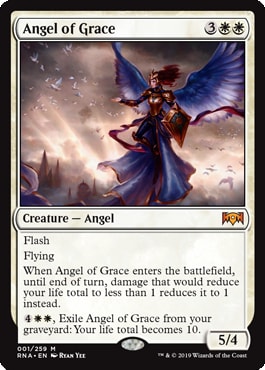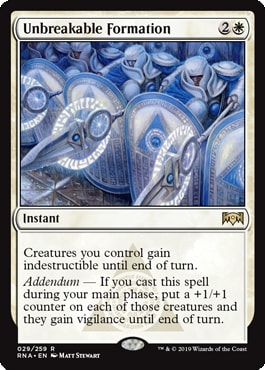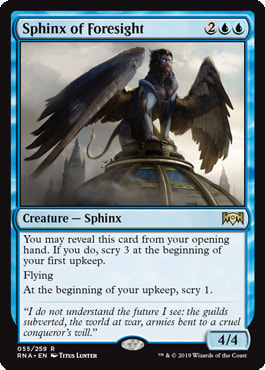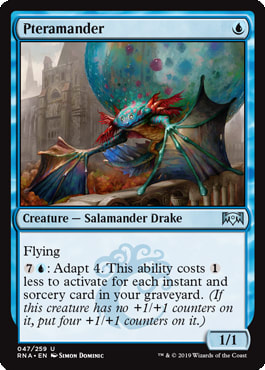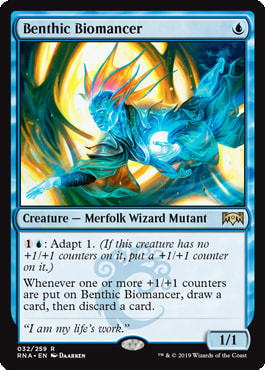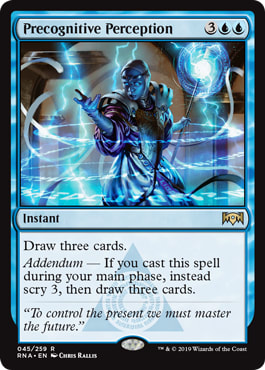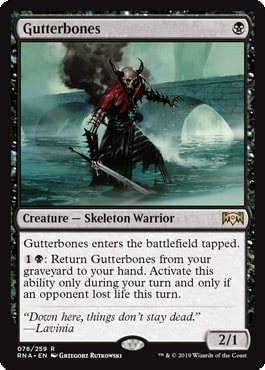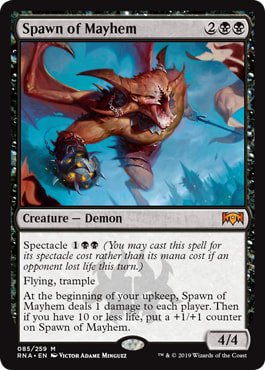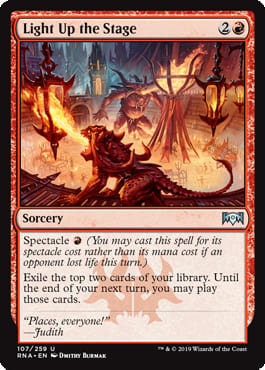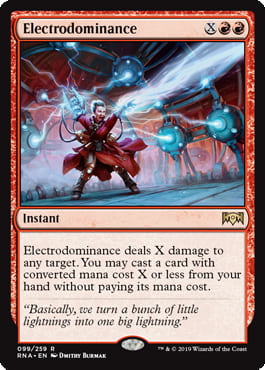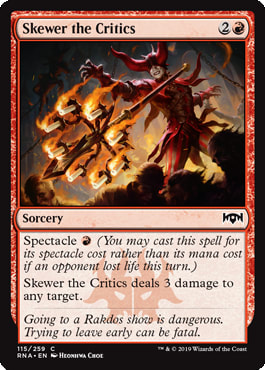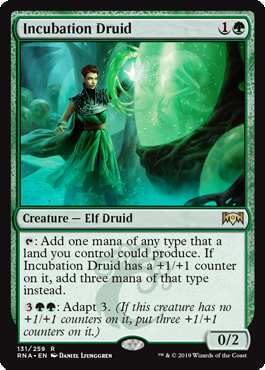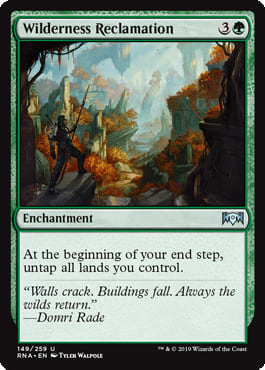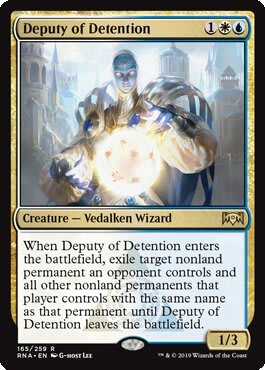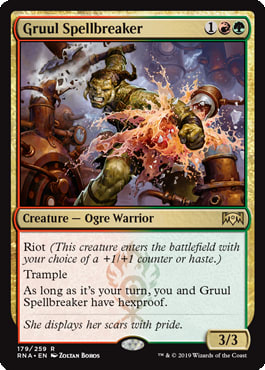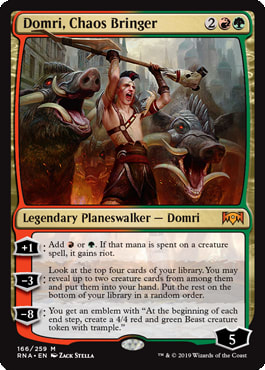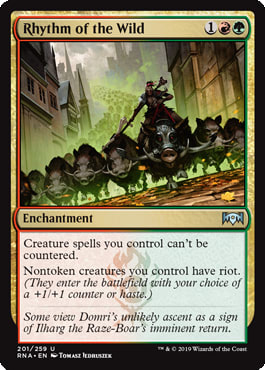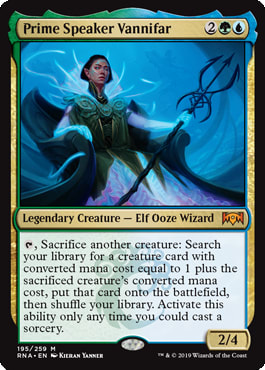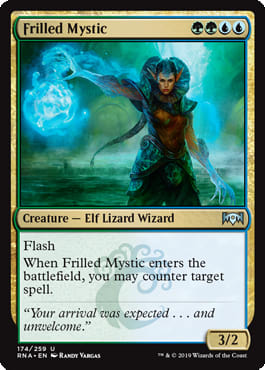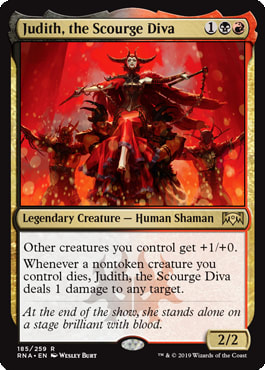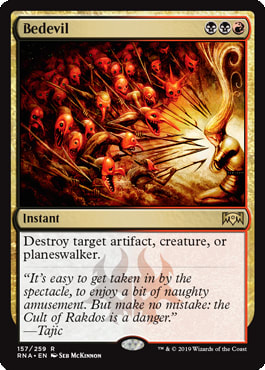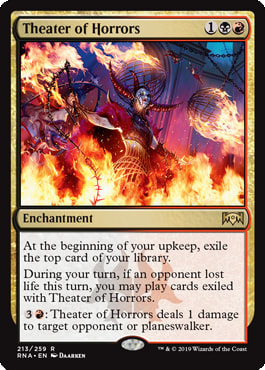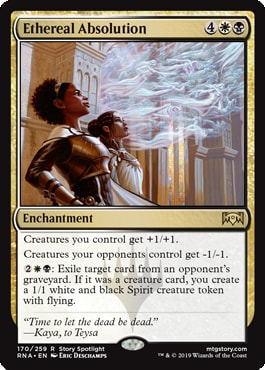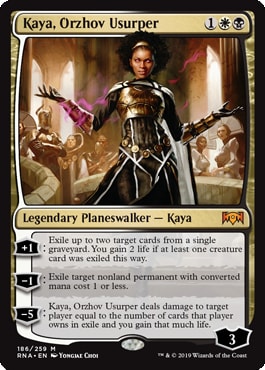Guilds of Ravnica was one of the best Cube sets we've seen in recent memory, with a solid cast of obvious adds like Goblin Cratermaker and a host of other non-obvious adds like Risk Factor.
Ravnica Allegiance isn't as good as Guilds of Ravnica for Cube, but it's still a pretty solid set, offering workhorses and non-obvious additions for non-competitive slots, with a few exceptions.
Like Guilds of Ravnica, it's another set developed after the Play Design team was implemented, with Play Design impact but not full Play Design focus.
Of note: Although this set review is being released after the set's been released in the wild and the Mythic Championship Cleveland happened, these evaluations are based on actual play in my Cube and not just outsourced to other formats; if I'm saying a card has been working well based on my experience, it's based on experience from trying them out in my Cube (it has power but my experiences likely should mirror yours, assuming it has rares.) These articles, therefore, generally tend to come out a while after a set drops, so I can get in a lot of reps with these cards and provide concrete information, rather than speculation and hypotheticals. That and I'm slow at writing.
As I've been doing in recent reviews, I'll be referencing decks that have utilized Ravnica Allegiance cards that won/had the best record in Cube drafts. Of course, going 3-0 with a card in a deck isn't ironclad proof of a card being good, but I'll be citing how these cards have manifested in winning Cube decks.
White
Tithe Taker - The origin of the "Death and Taxes" name started with the idea that there are only a few certainties in life: death, taxes, and someone playing White weenie in a tournament, with the deck initially playing creatures like Isamaru, Hound of Konda. So, Death and Taxes had more resemblance to White aggro decks that you see in cube - at least, in those that support White aggro enough for it to be a significant part of the meta.
Over time, the deck became more of a prison-style deck with cards that tax the opponent's resources, utilizing small value creatures, keeping the opponent off balance for long enough to let your army of small creatures win. Why does this matter for Tithe Taker? It's a card that hits on both riffs of Death and Taxes' timeline.
Per Emma Handy's article on hate cards, Tithe Taker is more of a "Prison" than a Floodgate that outright stops the opponent from doing things, albeit, to a minor degree to where it never completely shuts out an opponent but merely gets in their way of doing things on your turn.
Mono-white hate bears like Grand Abolisher, True Believer, Kataki, War's Wage, and Aegis of the Gods have seen little Cube play because their raw stats aren't that good and their abilities aren't guaranteed to come up in a game, let alone a match.
There have been some exceptions, as cards like Ethersworn Canonist (which I've been impressed by, even outside of artifact-heavy White aggro decks, since it hoses things like cantrips), Imposing Sovereign, and Thalia, Guardian of Thraben see significantly more Cube play because of how much impact they have on most game states, even if they're just attacking for 2.
Tithe Taker's ability, like the first group, can vary from useful to useless. I slacked on soliciting direct feedback from drafters on how annoying Tithe Taker's ability was in gameplay but I found forcing opponents to play removal at sorcery speed more often, hosing fetchlands, protecting creatures from dying in response to being equipped, countermagic, and even taxing cards like Opposition was often worthwhile.
It's tempting to say that this is a "White Goblin Piker with marginal upside" as cards like Loyal Cathar and Martyr of Dusk aren't exactly tearing up Cubes either, their 2-power bodies failing to put forth a huge clock on their own. However, I've found that, like with cards like Hangarback Walker, the sum of the parts has helped to make a good, resilient threat, as I've seen it utilized well in White aggro decks for disrupting an opponent and, as counterintuitive as it may seem, getting a 1/1 flyer has helped those aggressive decks fight through mass removal and can pick up equipment and hit the ground running. Afterlife 1 was relevant in aggro mirrors and on defense - while not being an embarrassing maindeck card like Lone Missionary.
Overall, I found it to be solid. White 2-drops aren't exactly absurd and I've liked this enough to have it stick around for a while.
Angel of Grace saw little play and the "flashback" ability was hardly used when she was. Because of this, she's going to have a rough time breaking into your Cube because White 5-drops in both the Baneslayer and army-in-a-can varieties are better than this.
Unbreakable Formation's sorcery speed mode and instant mode play very differently in terms of overall function since sorcery mode pushes forward damage and encourages chump attacks, while being cast as an instant makes it more of a combat trick/piece of insurance against mass-removal. It generally saw more play as a sorcery speed card as a one-shot anthem. You don't tend to see a lot of standalone anthems in Cubes nowadays as they're bad topdecks and pale in comparison to equipment for general efficiency; Unbreakable Formation played better than most anthems, but isn't something that stacks up well against premiere non-creatures in White. It's certainly not embarassing in the final 40 of an aggro deck, but it's harder to include in a White Cube section. If you have the room, go for it.
Blue
Sphinx of Foresight - It's sad that nowadays a foru mana 4/4 flier is meh but that's where we're at in 2019. It's still solid as a way of helping with mulligan win rates, making sure you aren't as reliant on card draw to dig you out.
Let's be honest - unfortunately, a 4 mana 4/4 isn't amazing for a Cube body, much to the chagrin of the Breezekeepers and Extravagant Spirits of yesteryear. No payoff until upkeep is also not the best either, since it requires tapping out (if cast on t4) with no immediate return, a questionable thing for Blue control decks in Cube and while it's no Serum Powder in terms of how bad the actual card is when in play, it's usually been pretty good - it mirrored how I found that Curator of Mysteries being a 4/4 beatstick wasn't the most efficient thing in the world, but it was still fine at beating down and adding an upkeep scry was nice. That said, it's a 4-drop that you have to play in your main phase in a Blue deck, and found that most Blue decks didn't want to spend their first 4 mana on it.
4 mana tends to be pretty clogged in Cube and I didn't really find it to be that much better than most of the middle-of-the-pack things and as much as I thought that it was an interesting effect, I found that it was, in the grand scheme of Cube middle drops, just ok.
Mesmerizing Benthid - Octodad provides a ton of value and is a pretty underrated pile of value that gums up the ground super well, like in this 3-0 deck:
Example Deck #1 | Cube | Usman Jamil
- Creatures (15)
- 1 Blade Splicer
- 1 Deputy of Detention
- 1 Ethersworn Canonist
- 1 Figure of Destiny
- 1 Gideon's Lawkeeper
- 1 Isamaru, Hound of Konda
- 1 Mardu Woe-Reaper
- 1 Mesmerizing Benthid
- 1 Palace Jailer
- 1 Phantasmal Image
- 1 Phyrexian Revoker
- 1 Pteramander
- 1 Selfless Spirit
- 1 Tithe Taker
- 1 True-Name Nemesis
- Planeswalkers (2)
- 1 Dovin, Grand Arbiter
- 1 Elspeth, Sun's Champion
- Instants (2)
- 1 Abeyance
- 1 Disenchant
- Enchantments (4)
- 1 Banishing Light
- 1 GO TO JAIL
- 1 Oath of Jace
- 1 Treachery
- Artifacts (2)
- 1 Mox Ruby
- 1 Smuggler's Copter
- Lands (15)
- 2 Island
- 9 Plains
- 1 Evolving Wilds
- 1 Hallowed Fountain
- 1 Marsh Flats
- 1 Tundra
(In all honesty, this deck likely would have just been better with its curve topping out at four, but I wanted to get some reps in with Octodad and try it out.)
Oddly, it worked out well here and it's been performing decently at being a generic value thing, like a Blue Cloudgoat Ranger that gums up the ground. I found that the ability to lock down big creatures is great (including an End-Raze Forerunners when it + the team was swinging for not quite lethal) and is pretty hard to kill since it requires either a ton of spot removal spells or a mass removal spell.
Blue 5-drops, at least for creatures, are on the weak side in Cube with Mulldrifter and... that's about it (Meloku and Morphling are awfully outclassed nowadays, to the point where The Third Power's current podcast tokens don't even have the Meloku Illusion anymore, due to low Cube adoption rates) and Clocknapper (for those using un-cards) with planeswalkers contributing the most value. It's another card where, if included, it may not last very long but it'll make the final 40 of a good chunk of Blue decks.
Mass Manipulation has a starting cost of ![]()
![]()
![]()
![]()
![]() . There's not really a good "base rate" cost for this in a Cube deck, as it's mostly a wonky Confiscate. Cards like Quarantine Field at least have a "base rate" cast that isn't too bad. Mass Manipulation starts out with too high of a Blue commitment to be worth it, even in Mono-Blue, because cards like Cryptic Command and Vedalken Shackles perform that role while at least being playable in 2-color decks. Don't bother.
. There's not really a good "base rate" cost for this in a Cube deck, as it's mostly a wonky Confiscate. Cards like Quarantine Field at least have a "base rate" cast that isn't too bad. Mass Manipulation starts out with too high of a Blue commitment to be worth it, even in Mono-Blue, because cards like Cryptic Command and Vedalken Shackles perform that role while at least being playable in 2-color decks. Don't bother.
Pteramander - Pterri was a hallmark card of Autumn Burchett's winning Mythic Championship Cleveland deck, so there's the temptation to assume that this is good in Cube.
The problem with these kinds of "instant/sorcery speed matters" cards is that they tend to suffer because Limited decks naturally tend to have a higher land count and things like planeswalkers, enchantments, and artifacts diluting the number of "hits" on Pterri.
Pterri has been compared to Delver of Secrets, although this comparison suffers because Delver's primary component of success was how much good library manipulation was in the deck, and secondarily the number of instants and sorceries as Delver was terrible without a playset of Ponders, Preordains or Brainstorms to complement it, since referring to a deck as "Preordain-Delver" is much less catchy than a "Delver deck."
Pterri isn't reliant on library manipulation, but moreso cheap instants and sorceries. While Constructed Delver decks generally have a boatload of cheap instants and sorceries, it's more a function of the deck being a low-cost Xerox deck that can skimp out on land counts and it being user error to not utilize the strong library manipulation that is available for those decks, when cards like Ponder, Preordain and Brainstorm are available.
The deck above had Mesmerizing Benthid and Pterri, but it never adapted. Admittedly, it's a terrible deck for Pterri with so few instants and sorceries in it. Control decks weren't really interested either, since they weren't in the market for a card that spent time as literal Flying Men, even if it had the promise of adapting later, since Flying Men was a dead card until it adapted. A 1/1 flier was antithetical to the control deck's game plan.
So what kind of Cube deck does want it? A deck that utilizes Pterri well has to have a critical mass of cheap and proactive instants and sorceries that it can cast so that Pterri can adapt in a consistently early manner.
(Clearly, the deck above wasn't it.)
I find that having the stars align to make Pterri work in Cube just didn't happen, with the best uses being Snapcaster Mage (which is just an absurd card) and Augur of Bolas in rarity restricted Cubes as they don't have as many good enchantments and artifacts and no planeswalkers to dilute the hits.
Recently, at MagicFest Memphis, I rotisserie drafted this 3-0 monstrosity in Quadnines' cube. This may be the best example of a deck to play Pteramander:
Example Deck #2 | Cube | Usman Jamil
- Creatures (8)
- 1 Arcane Savant
- 1 Pestermite
- 1 Phyrexian Revoker
- 1 Snapcaster Mage
- 1 Spellskite
- 1 True-Name Nemesis
- 1 Vendilion Clique
- 1 Venser, Shaper Savant
- Instants (9)
- 1 Brainstorm
- 1 Cryptic Command
- 1 Dig Through Time
- 1 Force of Will
- 1 Force Spike
- 1 Mana Drain
- 1 Mystical Tutor
- 1 Remand
- 1 Spell Pierce
- Artifacts (4)
- 1 Heirloom Blade
- 1 Mind Stone
- 1 Mox Jet
- 1 Vedalken Shackles
- Lands (16)
- 15 Island
- 1 Mishra's Factory
(Arcane Savant was naming Tooth and Nail)
And even still, I don't think that this deck would be improved with a Pteramander. Mind Stone may be a fine cut but even then, Pteramander likely would be spending too much time as a Flying Men and not as a Dragon. Even in cubes running a lot of "bad cantrips" like Omen, Pterri still doesn't get there.
Overall, I found Pteramander to be lackluster. I don't see WoTC printing more cheap Blue spells that will break into Cubes, but if that does happen, Pteramander may be worth another look. For now, it's another card that's great in Constructed, but fares worse in Cube.
Benthic Biomancer is yet another Blue 1-drop for tempo decks. There's some reanimator use but I found that those decks didn't really want to bother since it costs mana to use and it's a one-shot effect. This would have been better than Pterri in the deck above, but even with how often I see u/x tempo decks occur (aka how often I end up in my favorite Cube deck) I couldn't justify it being in my Cube. Don't be too surprised if it doesn't end up in yours either.
Eyes Everywhere hasn't gotten a lot of attention and it may be because it isn't a stellar draw spell, but I've found it to be pretty good, even if I'm quite a ways from putting it in my Cube as a scry engine with some interesting play (like being able to "pressure" planeswalkers and steal things to alpha strike). It plays weirdly against Blue but it doesn't automatically become bad against them, but does require some care if using the theft ability. That being said, I didn't find it as good as draw spells like Compulsive Research, Thirst for Knowledge, and Oath of Jace, so it likely is going to be muscled out of your cube.
Precognitive Perception is another 5-mana value play that played much better than analogues like Tidings and (obviously) Jace's Ingenuity, as the ability to scry 3 deep if need be was really nice, especially for long-term planning or digging for a specific card. Unfortunately, it suffers similar issues as Eyes Everywhere, combined with being a big Blue spell, which Cubes are generally not in short supply of.
Black
Gutterbones - I'm sure you've heard the song and dance where you should play this in your Cube if you support Black aggro and avoid it if you don't. This applies here too. It's no Bloodsoaked Champion (that card is pushed) but it's been performing well and is pretty close to the ol' champ, even if Gutterbones goes back into your hand.
Spawn of Mayhem - aggro decks aren't as reliant on their later drops as they are on their 1-drops, but this has been, by far, the best marquee 3-drop for Black aggro in Cube.
The "bleeding" bonus of getting larger is nice but great even without it, as I've found it to be an incredibly fast clock even if it just stays as a 4/4 with flying and trample.
I haven't seen it crack a 3-0 decklist (it's been close) but this 3-0 decklist comes from my friend SirFunchalot's (unpowered) cube: that featured both of these Black aggro powerhouses:
Example Deck #3 | Cube | Usman Jamil
- Creatures (17)
- 1 Bloodsoaked Champion
- 1 Brain Maggot
- 1 Carnophage
- 1 Dark Confidant
- 1 Drana, Liberator of Malakir
- 1 Dread Wanderer
- 1 Gravecrawler
- 1 Gutterbones
- 1 Isareth the Awakener
- 1 Mardu Strike Leader
- 1 Mesmeric Fiend
- 1 Mindblade Render
- 1 Ruin Raider
- 1 Scrapheap Scrounger
- 1 Spawn of Mayhem
- 1 Tormented Hero
- 1 Vampire Lacerator
- Sorceries (4)
- 1 Duress
- 1 Hymn to Tourach
- 1 Inquisition of Kozilek
- 1 Thoughtseize
- Enchantments (1)
- 1 Nether Void
- Artifacts (3)
- 1 Grafted Wargear
- 1 Heirloom Blade
- 1 Smuggler's Copter
- Lands (15)
- 15 Swamp
Like with Gutterbones, it's an easy add if you're supporting Black aggro and an non-inclusion if you're not. It's better in non-aggro than Gutterbones, at least, but Black midrange, combo, and control decks generally aren't in the market for a pile of stats, especially if they have to pay retail cost for this.
Drill Bit suffers from being mostly a Thoughtseize that only Black aggro wants, since its fail-case of Coercion is just terrible. Unlike the previous two cards, the timing windows were too narrow and unlike Light Up the Stage, it just wasn't worth the fail cases. Trust me, I really wanted to like it, but it just doesn't do much.
Pestilent Spirit is mostly an evasive threat and acts as an honorary Rakdos card due to giving spells deathtouch, but found that it's just fine in non-Rakdos Black decks since the base rate 3/2 for 3 for menace and deathtouch was hard to block. This made it so that unless the opponent is on tokens or aggro, the Spirit either goes unblocked or takes down several threats with it.
The combo of Menace and Deathtouch is rare, appearing only on mediocre cards like:
Dire Fleet Ravager and... Kederekt Creeper, not counting things which get a keywords conditionally.
Black 3-drops are pretty shallow, and most of the good ones are for aggro, Ophiomancer aside (Bone Shredder is real clunky.) Like Spawn of Mayhem, this is yet another one for aggressive decks. If room is tight and if for some reason there can only be one new 3-drop Black creature in your Cube, make it Spawn of Mayhem and if you have room for two, give this a whirl.
Orzhov Enforcer is better than you think as a roadblock with some value attached as a weird Moat-style effect to discourage attacking, and I found that the synergy with sacrifice effects was nice if she ever needed to become a 1/1 flier to get through clogged board states.
Example Deck #4 | Cube | Usman Jamil
- Creatures (15)
- 1 Braids, Cabal Minion
- 1 Dread Wanderer
- 1 Goblin Welder
- 1 Gonti, Lord of Luxury
- 1 Gravecrawler
- 1 Gutterbones
- 1 Judith, the Scourge Diva
- 1 Oona's Prowler
- 1 Orzhov Enforcer
- 1 Pack Rat
- 1 Pestilent Spirit
- 1 Porcelain Legionnaire
- 1 Ravenous Chupacabra
- 1 Tasigur, the Golden Fang
- 1 Viscera Seer
- Planeswalkers (1)
- 1 Daretti, Ingenious Iconoclast
- Sorceries (5)
- 1 Chainer's Edict
- 1 Demonic Tutor
- 1 Duress
- 1 Light up the Stage
- 1 Thoughtseize
- Enchantments (1)
- 1 Theater of Horrors
- Artifacts (2)
- 1 Smuggler's Copter
- 1 Sword of Body and Mind
- Lands (16)
- 3 Mountain
- 9 Swamp
- 1 Blinkmoth Nexus
- 1 Bloodstained Mire
- 1 Darksteel Citadel
- 1 Marsh Flats
It isn't quite Tithe Taker but it's been surprisingly decent as a filler black 2-drop. This deck likely would have wanted something else over Orzhov Enforcer like a Kitesail Freebooter, Dark Confidant, or even something like an Heir of Falkenrath. Still, this isn't bad, but don't be surprised if it doesn't last long in your Cube.
Priest of Forgotten Gods requires a bit too much effort for the work, and the payoff isn't that great for what it offers. It requires either a ton of recursion or some dedicated token fodder to work. It at least doesn't require another sacrifice engine like Skirsdag High Priest but the Priest didn't do much when I tried it - I'm not really going deep on sacrifice synergies either (currently I'm running Viscera Seer, but not Carrion Feeder.) Overall, while it's not unheard of for Cubes to have cards for Aristocrats, the payoff for this individual card just isn't there.
Red
Light up the Stage had many knobs turned on it to make it a solid performer as being able to play lands and being able to play things until the next end-of-turn step resulted in scenarios where typically it was rare for the caster to lose on cards revealed from Light up the Stage. It reminded me, oddly, of Hangarback Walker, where if one of the knobs wasn't turned as much as it was, it likely would have been out of cube range. Thankfully, this wasn't.
I found that Light up the Stage plays poorly with splashes and high cost finishers, since they increase the whiff rate. The first impression was this 3-0 deck with it, where post-combat, Light up the Stage cast via spectacle revealed a mountain and a Swiftspear and performed well all night.
Example Deck #5 | Cube | Usman Jamil
- Creatures (12)
- 1 Bloodbraid Elf
- 1 Bomat Courier
- 1 Dryad Militant
- 1 Firedrinker Satyr
- 1 Flametongue Kavu
- 1 Goblin Guide
- 1 Kari Zev, Skyship Raider
- 1 Monastery Swiftspear
- 1 Porcelain Legionnaire
- 1 Rhonas the Indomitable
- 1 Scavenging Ooze
- 1 Zurgo Bellstriker
- Planeswalkers (1)
- 1 Domri, Chaos Bringer
- Instants (5)
- 1 Fireblast
- 1 Lightning Bolt
- 1 Magma Jet
- 1 Searing Spear
- 1 Smash to Smithereens
- Sorceries (1)
- 1 Light up the Stage
- Enchantments (1)
- 1 Sylvan Library
- Artifacts (5)
- 1 Black Lotus
- 1 Grafted Wargear
- 1 Heirloom Blade
- 1 Mana Vault
- 1 Mox Emerald
- Lands (14)
- 1 Forest
- 7 Mountain
- 1 Arid Mesa
- 1 Rishadan Port
- 1 Savannah
- 1 Taiga
- 1 Treetop Village
- 1 Wooded Foothills
The only real bad thing about it is that only aggro decks want it (playing it midrange, control or combo results in a very high whiff rate) and it doesn't go to the dome. Recent cards like Experimental Frenzy and Risk Factor help reward low-curve aggro decks and essentially, this is yet another one of those cards. Inclusion depends on if you want another one of these cards and I'd say it's worth doing.
Rix Maadi Reveler - is a decent filler for Red aggro decks. One of the first things I did with my cube was (be the first to) consider Kird Ape to be a Gruul card and this, therefore, may be surprising I consider this a Red card, not Rakdos. This was from finding that when Rix Maadi Reveler was played, it was almost always a Red 2-drop rather than for the ![]()
![]() Spectacle cost. Occasionally, it was played in mostly Red decks with a few Black sources but it generally was just another Red aggro creature that happens to draw a card when hellbent.
Spectacle cost. Occasionally, it was played in mostly Red decks with a few Black sources but it generally was just another Red aggro creature that happens to draw a card when hellbent.
Even when trying it as a reanimator/graveyard support card, it'one-shot effect, so it wasn't great in that role either. Red isn't really in need of more filler 2-drops and this registers on the lower end of cubability for those. It's another card to encourage low-to-the-ground Red aggro decks, something that's been more of a theme lately; but, even then, other Red aggro cards have done that job better.
Skarrgan Hellkite has been underrated but I've been very happy with how it's performed. Having riot gives the Hellkite a lot of play as a big "Baneslayer" style threat or a hasty chunk of damage. Ironically, Skarrgan Hellkite reminded me of Glorybringer, a creature that was initially underrated by many since it wasn't as big as Thundermaw Hellkite, but I called it as being powerful during set review time. It was likely underrated because Glorybringer worked counter intuitively for aggressive decks (since exerting felt like a real cost) and while Skarrgan Hellkite can't Flame Slash anything when it attacks, it makes up for it with incredible flexibility.
I found the ability to get a counter was useful when trying to "go big" on the opponent and/or find yourself flooded, as it was very useful for situations like aggro mirrors; even being a 5/5 flying wall typically meant that it was stonewalling the opponent's offense. Paying ![]()
![]() is, in the grand scheme of things, a pretty poor rate for a Forked Bolt, but found that it was nice to do some chip shots when attacking isn't safe/when you want to have the 5/5 flier back.
is, in the grand scheme of things, a pretty poor rate for a Forked Bolt, but found that it was nice to do some chip shots when attacking isn't safe/when you want to have the 5/5 flier back.
Skarrgan Hellkite survives Wildfires and, unlike a lot of dragons like Thundermaw, I've found that when it's in "slow mode", Skarrgan Hellkite is something that I actually want in a slower Red deck. Once you go from ![]()
![]()
![]() to
to ![]()
![]()
![]() , it's usually lights out. Aggro decks do lose out on Thundermaw's 5/5 hasty body to kill small fliers and Glorybringer's 4/4 hasty Flame Slashing body, but it still wasn't bad when Skarrgan Hellkite needed to just off a planeswalker or a player.
, it's usually lights out. Aggro decks do lose out on Thundermaw's 5/5 hasty body to kill small fliers and Glorybringer's 4/4 hasty Flame Slashing body, but it still wasn't bad when Skarrgan Hellkite needed to just off a planeswalker or a player.
In terms of rankings, it's amongst the best Red 5-drops - easily able to compete with Thundermaw-style big dragons and the combo elements of Kiki-Jiki, Mirror Breaker and Zealous Conscripts. I often find people too scared to try new things out, when there are many "safe" things to fall back to. Try this; you'll be pleasantly surprised.
Electrodominance is essentially a way of giving kicker to Volcanic Geyser with a ton of potential for interesting stories as a big Red instant damage dealer to pick counterspell fights and put things into play at instant speed. However, I found that at the end of the day, ![]()
![]()
![]() was just too much mana for the base rate and it didn't seem to pay off until it got to something like
was just too much mana for the base rate and it didn't seem to pay off until it got to something like ![]()
![]()
![]() mana.
mana.
Usually decks ended up playing their hands out instead of holding onto something for a big blowout play unless they were drawing a boatload of cards. The most "impressive" thing I saw was it being used for ![]()
![]()
![]() to deal 2 to a Baneslayer and casting an Incinerate for free to finish it off. Oh boy! Aside from that, it didn't seem to play particularly well from trying it out.
to deal 2 to a Baneslayer and casting an Incinerate for free to finish it off. Oh boy! Aside from that, it didn't seem to play particularly well from trying it out.
Since Electrodominance is bad at low X amounts, aggro decks couldn't really use it since their damage spells need to be efficient. Slow Red cards generally need to do a lot of work to make it worth including something with such a narrow scope. Unfortunately, it didn't.
Skewer the Critics was a card that I was initially hot on for Cube but my impressions have since cooled down. I knew that it was terrible at getting rid of blockers, like Tragic Slip, and it's at least better than something like Lava Spike, which is incredibly narrow.
Cards like Incinerate, Searing Spear, and Lightning Strike are playable in just about all Red decks, since they can deal with creatures relatively cleanly and even the Volcanic Hammers out there which deal 3 damage to any target. Skewer the Critics draws comparisons to Rift Bolt and I'd say that this is better than the old Rift Bolt, but overall, I wasn't too big a fan of it since the payoff for getting spectacle was essentially another Bolt.
I've talked about how there's been a lot of great incentives to critically look at your Red aggro sections to make sure that they're sleek and efficient, and Skewer does favor that kind of Cube design, since only Red aggro wants this, but I just found it too narrow to make it outside of many rare-restricted Cubes.
Green
End-Raze Forerunners has performed well as a slightly worse Craterhoof Behemoth, but considering how good Craterhoof is at ending games, that's hardly a bar for inclusion.
It's worse at ending games in wide board states, and I generally found that when decks had access to both, Craterhoof was almost always the preferred tutor target, but it had some nice upsides. It having and granting vigilance may look like flavor text, but it's been useful for alpha strikes that go awry. While it doesn't always give you the win, it's been at least preventing an outright loss when those blowouts occur.
I also found that it being a sizable threat on its own was useful for scenarios when the dust settles and neither a Craterhoof or a Forerunners trigger would end the game. A 7/7 trampling vigilant body generally had to be respected, since it couldn't be chump blocked all day. The deck that had Mesmerizing Benthid had a scenario when the opponent had a non-lethal Forerunners + board state, bringing the Benthid player to 5 life. Had the Benthid player not had removal, the big pig would have ended the game soon after.
In theory, Forerunners is also a better reanimation target than Craterhoof, but I never really saw that happen either. Green 8-dropss in Cube generally manifest as either "overrun" types of effects (Hoof, Decimator of the Provinces, Forerunners) and giant monsters that destroy non-creatures. The mix that you want to have mainly depends on what you want to support, since the latter category favors cheaty shenanigans and the former celebrates go-wide ramp decks. It's something good to have in your toolbox.
Guardian Project is similar to Lifecrafter's Bestiary, a card that helps midrange decks grind through midrange mirrors and control matchups by giving them card advantage off of non-token creatures coming into play. Overall, it's been better than Lifecrafter's Bestiary, since triggering for free meant midrange decks could just play normally while drawing cards. In most games, it generally was better than Harmonize in terms of how many cards were drawn and despite being a bad top deck, it overall performed well for those decks. Green lacks direct card advantage since a lot of its card advantage gets lands, so it was nice for those Green midrange decks. The only real thing against it is that it's a 4-mana Green sorcery speed card and thus gets punished hard by cheap countermagic, but I found in those scenarios it was more something to cast when the time was right rather than just at four mana (similar to something like a 4-mana Garruk.) It looks wonky but don't count it out for Cube.
Biogenic Ooze is more of a Huntmaster of the Fells (as it makes a body and has inherent value even if killed with instant-speed removal) than Whisperwood Elemental, which gets owned by instant-speed removal. While Biogenic Ooze doesn't make Manifest tokens that can possibly become large threats, or have an ability that protects against wraths, I've found that Green midrange decks have utilized Mr. Booze extremely well. It has some spot removal insurance since it at least leaves 2 power behind if it dies to a Doom Blade, but snowballs really quickly if it isn't dealt with.
The ![]()
![]()
![]()
![]() mode to make a 2/2 Ooze isn't incredibly efficient, but like Walking Ballista's ability to put counters on itself, it helps to use excess mana that these types of decks have lying around and a few activations can really become overwhelming. Like with Skarrgan Hellkite when it goes big in "go big" matchups, getting from 5 to 8 mana isn't out of the question, and even easier for Green ramp decks. Once Biogenic Ooze makes two tokens a turn, it's usually GG.
mode to make a 2/2 Ooze isn't incredibly efficient, but like Walking Ballista's ability to put counters on itself, it helps to use excess mana that these types of decks have lying around and a few activations can really become overwhelming. Like with Skarrgan Hellkite when it goes big in "go big" matchups, getting from 5 to 8 mana isn't out of the question, and even easier for Green ramp decks. Once Biogenic Ooze makes two tokens a turn, it's usually GG.
Overall, I've been very impressed by it for midrange decks, and as Green 5-drops aren't exactly bursting at the seams, this is a good one.
Incubation Druid is an odd ramp card, but I found myself more impressed with it over time, since it can use its own mana to adapt itself, which I found to be useful for not only being able to cast ramp targets later, but to threaten to be a 3/5 on defense to stymie attacks. Overall impressions were pretty good, but not quite to the level of things like Sylvan Caryatid and premiere 1-mana ramp like Utopia Sprawl, Birds of Paradise and Wild Growth.
Wilderness Reclamation is absurd in Constructed because of Nexus of Fate but tapping out generally wasn't worth the payoff, I found.
It played somewhat similarly to a tap-out card like Bitterblossom in Faeries, where you tap out for a bit for the potential of being able to play an instant/flash game more, but Wilderness Reclamation doesn't do much on its own, and I found that even other Cubes that focus on storm have found it poor. Tap-out control/ramp might want it with a lot of flash creatures and spells, but it hasn't really found a home in my experience, since simic decks tend to be tap-out control and ramp decks that usually only need to hold up a few mana sources. Humorously, if this was a Red card, it'd see a lot more Cube play since Izzet can use its mana at instant speed much better than Simic. Poor Simic.
Multicolored
Dovin, Grand Arbiter - is mostly for tempo decks (but may be pigeonholing it like with Experimental Frenzy) since slower Azorius decks can't really use the +1 ability aside from as a wonky way to keep him alive (ala Ajani Goldmane's +1.)
It played somewhat similarly to Bitterblossom, but with a smaller shelf life and added flexibility to keep it alive by being able to sustain itself and to threaten a super Dig Through Time. In my experience, while it doesn't explicitly say GAME OVER, I've found the game tends to end after a Dovin ultimate. It saw some play in slower control decks that utilized Azorius mana also, like this deck:
Example Deck #6 | Cube | Usman Jamil
- Creatures (7)
- 1 Chamber Sentry
- 1 Etched Champion
- 1 Glen Elendra Archmage
- 1 Hydroid Krasis
- 1 Phyrexian Metamorph
- 1 Sphinx of Foresight
- 1 Walking Ballista
- Planeswalkers (5)
- 1 Dovin, Grand Arbiter
- 1 Elspeth, Sun's Champion
- 1 Jace, the Mind Sculptor
- 1 Liliana of the Veil
- 1 Tezzeret, Artifice Master
- Instants (4)
- 1 Abrade
- 1 Beast Within
- 1 Force of Will
- 1 Secure the Wastes
- Sorceries (1)
- 1 Toxic Deluge
- Enchantments (7)
- 1 Treachery
- 1 Batterskull
- 1 Boros Signet
- 1 Dimir Signet
- 1 Mox Pearl
- 1 Selesnya Signet
- 1 Smuggler's Copter
- Lands (16)
- 1 Forest
- 1 Plains
- 1 Swamp
- 8 Island
- 1 Badlands
- 1 Plateau
- 1 Taiga
- 1 Temple Garden
- 1 Volcanic Island
However, this was more the exception than the rule and it was mostly played in tempo and aggro. There's some better tempo cards available in previous sets and this one, but if you're looking for something that can also be played in slower Azorious decks but not as good at being universally playable as something like Spell Queller. Still, it's better than you likely think.
Deputy of Detention is another great card that's gotten a bit of a bad rap because of how it compares to Detention Sphere, even though they're for completely different decks, despite similarity in appearances.
Cards like Leonin Relic-Warder are odd ducks, because they don't outright kill something, therefore, they're bad as straight-up removal. However, like I previously mentioned, disruptive hate bears work on the Death and Taxes axis of disrupting the opponent while beating the opponent down. Sure, if the opponent Tinkers out a Blightsteel Colossus, you can have the cat sit on a giant robot and hope it gets there, but that's likely not gonna work out.
But that's fine, because its primary job is to sit on a rock and slow your opponent down so you can end the game before your opponent's bigger mana threats take over. Like with Leonin Relic-Warder, applying the "this dies to removal" trope to Deputy of Detention is a poor, reductive argument since it doesn't take into account how the cards actually play.
Even in the worst-case scenario, while it does "die to removal" -
- If your opponent *always* has the removal for this, you may be the unluckiest human alive, being even unluckier than this guy.
- If you're playing tempo, even nabbing a ham sandwich is fine because all you want to do is disrupt and attack. Having your creature killed is worse than having it live, making your opponent spend resources to dealing with it does work on the axis that your deck is working toward.
Being aware of what *could* occur in worst-case scenarios is important in-game but I've found over the years that assuming that the worst case is the always case doesn't reflect reality. Even when the "dies to removal" scenarios happen, it's significantly less bad for a 3-drop than a 5-6 mana card due to the discrepancy of mana invested by the removal player.
"Nicol Bolas, the Ravager's flip is ability is bad because it can just die to removal in response to the ability, so I just wasted a bunch of mana"
"My opponent can always choose the best outcome for them if I cast Risk Factor, so it's bad"
"Sometimes if I'm at 4 cards in my graveyard and loot with Jace, Vryn's Prodigy, I *want* to keep the looter side and therefore I can't loot"
Do those scenarios occur in-game? Sure, and it's something to be aware of when playing, but do these scenarios reflect how these cards play in reality? No.
As noted before, this isn't for control decks because it gets blown away from your own wraths, unlike Detention Sphere, however, that's ok, because that's not the deck that wants it - similarly to how white control decks don't want a Kytheon, Hero of Akros or White aggro decks don't want a Wall of Omens.
There's the argument that "No one plays Fiend Hunter anymore because the opponent getting the creature back sucks" but it's more that powerful White 3-drops like Recruiter of the Guard, Brightling, Hallowed Spiritkeeper and Thalia, Heretic Cathar pushing *out* the Fiend Hunters of the world from many Cubes.
Deputy of Detention doesn't bring a lot of power to the table on his own, but I found he's worked well in Azorius tempo decks by providing a source of damage, even if it's not a lot of damage.
Example Deck #7 | Cube | Usman Jamil
- Creatures (12)
- 1 Dauntless Bodyguard
- 1 Deputy of Detention
- 1 Dryad Militant
- 1 Figure of Destiny
- 1 Hallowed Spiritkeeper
- 1 Lavinia, Azorius Renegade
- 1 Man-o'-War
- 1 Student of Warfare
- 1 Thraben Inspector
- 1 Tithe Taker
- 1 Vendilion Clique
- 1 Venerated Loxodon
- Planeswalkers (4)
- 1 Ajani Goldmane
- 1 Dovin, Grand Arbiter
- 1 Elspeth, Knight-Errant
- 1 Gideon Jura
- Instants (2)
- 1 Mystic Confluence
- 1 Remand
- Sorceries (2)
- 1 Council's Judgment
- 1 Ponder
- Enchantments (4)
- 1 GO TO JAIL
- 1 Legion's Landing
- 1 Oblivion Ring
- 1 Treachery
- Artifacts (1)
- 1 Black Lotus
- Lands (15)
- 5 Island
- 8 Plains
- 1 Gaea's Cradle
- 1 Rishadan Port
The issue with finding room for it is that although tempo is the current Azorius flavor du jour, most Azorius decks in Cube tend to be Paul Cheon control decks. Cards like Spell Queller and Geist of Saint Traft already help tempo, and if you have a small multicolored section, with Teferi, Hero of Dominaria and Fractured Identity, there isn't much more wiggle room for this. Larger multicolored sections can utilize Deputy of Detention, but even with it being a good card, sometimes good cards don't make it into Cubes because of room and archetype constraints. As a Cube designer, know that this is something in your toolbox to adjust archetypes.
Lavinia, Azorius Renegade - the Death and Taxes trope of Feast or Famine applies here as well, since she can either be a literal Grizzly Bears or a creature that's backbreaking and if it's the latter, I've found that she tends to swing games massively.
There's an argument that all she really hoses is moxen and other fast mana, and although it's the most obvious thing, I've found that she also tends to do a number on decks that utilize mana rocks and other Green ramp. While she can stop the opponent from ramping out an Ugin, the Spirit Dragon, she can't stop a Terastodon. Generally "big Green" ramp decks have a lot more Terastodon, but remember that just because a tempo card doesn't stop everything, that doesn't mean it's bad, since these tempo tools are meant to primarily slow the opponent down.
Her relative value does go down without fast mana and mana rocks in the mix as a predator is much worse without her prey and she's a nice example of a card that is explicitly worse without fast mana. Her value is a lot more variant than something as generally good as Tithe Taker. As always but even more so with Lavinia, context and your Cube's meta needs are key to determining how she will play out in your environment but overall she's in the mid-tier workhorse rank.
Ravager Wurm -has played decently as a big Flametongue Kavu type of effect and riot gave it some flexibility in being able to either size up against bigger threats or kill something small and attack either a player or a planeswalker. Being a base 5/5 would have let it size up against titans and does make it lose some play against bigger decks; it's unfortunately not as good at being a big ramp thing that kills opposing threats as Dragonlord Atarka. It's not bad, but I found if decks generally ended up cutting it since they only had so much room for 6+ drops, so it's quite a ways from making it into Cubes with small to medium sized multicolored sections.
Gruul Spellbreaker is a underrated beater possibly because of Gruul's role in Cube to be mainly midrange. Much like with Skarrgan Hellkite's ability to give itself a counter via riot, being able to be a 4/4 has come up when needing to "be the control deck" in aggro mirrors or needing to outmuscle 3/3 beast tokens. The ability to provide hexproof to its controller hasn't come up very often, though, but the ability to give itself hexproof definitely has. In a matchup where she made an appearance, it became a 4/4 and after the match, the opponent revealed a Lightning Strike that would have killed it otherwise.
Something like this would be welcomed with open arms in Mono-Red, and while it's objectively a good card, Gruul got a lot of goodies lately. Its inclusion may be difficult, especially if Gruul plays more of a ramp role, since I found it was mainly just played in Gruul beats.
Domri, Chaos Bringer is more of a midrange card than an aggro one since riot and big creatures is such a powerful combination. Midrange decks typically couldn't really use the +1 ability that well when it came out, but it usually made up for it by powering out hasty threats as attacking with a hasty Titan or Wurmcoil Engine is a wonderful feeling.
Although midrange is the best home for it, the previously noted Gruul aggro deck in the Light up the Stage section found it to be pretty good:
Gruul aggro is the best deck to utilize the +1 ability when cast with no extra mana available to power out a 1-mana creature with riot, which usually was a very good play. Domri's ability to "draw" cards is nice, and usually gets one creature, but it's not hard to get 2.
Domri does have one of the weaker ultimates, and one of the few that I've seen go off and have the caster still lose, as even though it's 8 power over a turn cycle, sometimes that just isn't enough.
Of course, it's yet another 4-mana card in a color combination with about a billion 4-mana cards, including several planeswalkers. I found that it's about as close as Xenagos, the Reveler and Huntmaster of the Fells - cards that are also midrange cards. Hardly essential, but a nice tool for customization if you have the space.
Rhythm of the Wild - is pretty similar to Domri but differs since it has the ability to be cast on turn two from a mana dork and has some nice synergy shenanigans with giving all of your non-tokens riot, letting persist creatures live forever. Making your creatures uncounterable is nice but only really matters against Blue, which does help midrange vs. control. Domri mainly wins out because "drawing" creatures helps it in scenarios where it could be a bad top deck, but it's pretty darn close; and, honestly, a Cube may just prefer Rhythm so that it doesn't have a glut of 4-mana cards.
Cindervines performed decently as a maindeck naturalize effect that wasn't embarrassing against decks that didn't have a lot of targets. The damage added up quickly. Because of this, it's mostly an aggro card with some play in slower Gruul decks/decks with access to Gruul mana as a miser's Seal of Primordium, but it was mostly for aggro. Obviously getting it out early means that damage can add up, but it was fine when cast mid-game. It performed better than things like Ravager Wurm, but was another generally fine Gruul card, something which is the theme with a lot of Gruul cards in the set.
Prime Speaker Vannifar may just be the manifestation of Devo and De-Evolution for Simic getting pretty mediocre/worse versions of other cards in Cube. Unlike with Deputy of Detention, this being on a body isn't useful since it slows down her ability to act as a Birthing Pod. This likely had to be nerfed for Modern as Birthing Pod was banned in Modern, but that was mainly on the ability to create robust value chains, which Prime Speaker Vannifar never could in my experience. Pass.
Growth Spiral was one of the first previews and thus a card that I got the most reps in with, and it's a somewhat close analog to Explore. Being an instant gave it a lot of extra value since it let decks hold up countermagic or just fire it off main phase if digging for something/needed to use the land drop's mana to only be "down" one mana. A lot of Simic cards don't actively *want* you to splash for them, like Dack Fayden, Fractured Identity, and Assassin's Trophy, but a lot of Simic cards are generally solid. It's similar to how Izzet was, prior to Conspiracy, when Dack Fayden and Dack's Duplicate were the leaders of the pack from a guild that previously just offered value burn spells (Electrolyze, Prophetic Bolt, Fire // Ice.) The only exception in Simic was Edric, Spymaster of Trest, which even then was only amazing in decks that were less rampy and more tempo-y.
Growth Spiral was like that in Simic, where it wasn't really worth splashing in Green, but it was playable in solidly Simic decks. Because of this, it's yet another decent Simic card that you can try out and that I was decently happy with, but wouldn't fault anyone for going either way with it.
Hydroid Krasis - if you've followed me on social media and/or been following my content, you'll note how much I dislike being reliant on outsourcing to other formats in lieu of critical thinking. You may also have noted that I said that Hydroid Krasis was terrible on the Ravnica Allegiance Third Power episode, so it may surprise you that my tone changed on it.
Why? I tried it out (albeit, later than I should have) and received feedback from my drafters that it was doing well in Green and Simic decks. I've learned that as a Cube designer and content producer, it's important to not stick your head in the sand so that you're continually improving and learning from why you've made the mistakes that you've made, rather than just quietly adopting new cards or simply thinking "Oh well, turns out this card is good" while losing sight of why the card was underestimated.
With Hydroid Krasis, I had underestimated its lowest non-embarrassing X value, where X is 4 as a "bad Mulldrifter" discounting how useful a 4/4 flying trampler is and how, when X is larger, made it so that the body that it created had to be at least respected, if not outright removed. It being a cast trigger generally was useful but like with Rhythm of the Wild, only really mattered against Blue decks.
I had utilized the argument that "it's bad early," which was erroneously applied to Sphinx's Revelation, since this discounted its use in the later stages of the game when flooding out, since drawing cards and gaining life (for both cards) chains toward deploying more big threats.
Hydroid Krasis also gives some payoff for splashing into Simic, rather than being a card that you only really want to play if you're solidly in simic, like Trygon Predator and Mystic Snake.
This made it worse than Nissa, Steward of Elements, as Hydroid Krasis required more mana to get to an acceptable floor than Nissa.
Hydroid Krasis highlights how Simic's multicolored cards were similar to Izzet's. Consider Hydroid Krasis in the non-Edric tier of Simic cards, that can be used to customize your Simic section, as Hydroid Krasis complements Green ramp strategies very well, especially those that can incidentally make Green mana via mana rocks and cards like Fertile Ground.
Frilled Mystic - I can't think of many Cubes that need another Mystic Snake, but in case you really need another one that's harder to cast for a slightly better power rate, be my guest. But I'd advise against it.
Judith, the Scourge Diva was initially deemed bad because she doesn't trigger on tokens. However, I found this was myopic analysis since she *does* work with tokens by boosting them with her Orcish Oriflamme, and giving them some real board presence and due to being able to target anything with her death trigger, she usually made combat math odd, and made it so creatures could trade up easily.
As you can expect, she's only for aggro decks but has been doing well there, like this deck:
Example Deck #8 | Cube | Usman Jamil
- Creatures (13)
- 1 Bomat Courier
- 1 Dark Confidant
- 1 Flesh Carver
- 1 Gravecrawler
- 1 Judith, the Scourge Diva
- 1 Kari Zev, Skyship Raider
- 1 Monastery Swiftspear
- 1 Plaguecrafter
- 1 Rakdos Cackler
- 1 Shriekmaw
- 1 Snapcaster Mage
- 1 Tasigur, the Golden Fang
- 1 Viscera Seer
- Planeswalkers (1)
- 1 Liliana of the Veil
- Instants (2)
- 1 Ancestral Recall
- 1 Wretched Confluence
- Sorceries (4)
- 1 Fiery Confluence
- 1 Gitaxian Probe
- 1 Light up the Stage
- 1 Thoughtseize
- Enchantments (1)
- 1 Experimental Frenzy
- Artifacts (3)
- 1 Grafted Wargear
- 1 Jeweled Amulet
- 1 Mox Pearl
She's less powerful than Kolaghan's Command and Daretti, Ingenious Iconoclast, but she's not far behind them and may very well be the 3rd best Rakdos Cube card.
Bedevil is an obvious riff to Hero's Downfall with some additional utility to hit artifacts to help it see more maindeck play. It doesn't quite crack the Top 4 Rakdos cards and it's yet another piece of removal in ![]()
![]() , which I've seen trend downwards in Cube adoption (ie. you don't see as many Terminates and Dreadbores nowadays in Cubes, even though Kolaghan's Command is almost always played.) Generally I found that straight-up Rakdos decks don't have issues casting Bedevil, but it can be a hard sell for your own Cube because it's "yet another removal spell." Like many things in this set, it's another tool for the toolbox.
, which I've seen trend downwards in Cube adoption (ie. you don't see as many Terminates and Dreadbores nowadays in Cubes, even though Kolaghan's Command is almost always played.) Generally I found that straight-up Rakdos decks don't have issues casting Bedevil, but it can be a hard sell for your own Cube because it's "yet another removal spell." Like many things in this set, it's another tool for the toolbox.
Rakdos, the Showstopper is just too unpredictable and inconsistent to be worth it, relying on the opponent to have creatures to be any good. It's mostly symmetrical, anyway. Multicolored cards should generally be very powerful to be worth the cost of being 2-color. It's questionable if it'd be worth it for even ![]()
![]()
![]() , but being
, but being ![]()
![]() , the new Rakdos doesn't have a chance in a lot of Cubes.
, the new Rakdos doesn't have a chance in a lot of Cubes.
Captive Audience - I tried this out since it's a unique, weird card and found the issue was that when it was cast, at least one of the modes wasn't too punishing for the opponent. This made it so that it took a while for the overall payoff to occur. For modes like Captive Audience's hand discard, seeing it coming from a mile away meant that the opponent could cast their best cards and brace for impact accordingly, as anyone who's played against a suspended Mindstab can attest to. I'm usually looking for unique cards that can help to bolster more unconventional archetypes and found Captive Audience wasn't even good at that.
Theater of Horrors is another card that surprised me and that I've been pleasantly surprised for Cube. Thanks to Kranny for giving it some love and getting me interested in trying it out.
I've found that it's not hard to trigger the "spectacle" mode and even the ability to ping someone, while not efficient, helps in stalled board states when you just need to close out the game.
The deck that had Orzhov Enforcer above had Theater of Horrors too and utilized Theater well as a cheap way of grinding out card advantage.
Like Judith, Theater of Horrors isn't too far off from the Top 2 Rakdos cards, and inclusion really can go either way. Both are aggro-only cards, but they're close enough in power level that inclusion is ultimately up to you.
Ethereal Absolution draws comparisons to Elesh Norn, Grand Cenobite but is on the weaker side in Orzhov since it does have little board impact. If the opponent has dead creatures, it does effectively create 2/2 fliers, but it relies on the opponent having creatures, which is a given in Ravnica Allegiance, but not as much in Cube. It also hoses 1/1s real hard, but by the time that the Orzhov player gets to six mana, 1/1s aren't exactly taking over the board state unless they're being created by something like Elspeth, Sun's Champion. There are simply better options available for cube owners for Orzhov.
Kaya, Orzhov Usurper - When I saw Kaya, like many, I was underwhelmed for her Cube potential. It became even more apparent when I looked at this recent 3-0 ![]()
![]() deck that looked like it wouldn't have been improved by adding Kaya.
deck that looked like it wouldn't have been improved by adding Kaya.
Example Deck #9 | Cube | Usman Jamil
- Creatures (13)
- 1 Aerial Responder
- 1 Dragon Hunter
- 1 Elite Vanguard
- 1 Fairgrounds Warden
- 1 Kongming, "Sleeping Dragon"
- 1 Mardu Woe-Reaper
- 1 Mother of Runes
- 1 Pianna, Nomad Captain
- 1 Porcelain Legionnaire
- 1 Rakdos Cackler
- 1 Serra Angel
- 1 Vampire Lacerator
- 1 Zulaport Cutthroat
- Instants (6)
- 1 Diabolic Edict
- 1 Disenchant
- 1 Harm's Way
- 1 Murderous Cut
- 1 Putrefy
- 1 Snuff Out
- Sorceries (2)
- 1 Demonic Tutor
- 1 Lingering Souls
- Artifacts (3)
- 1 Flayer Husk
- 1 Lightning Greaves
- 1 Oketra's Monument
- Lands (16)
- 5 Swamp
- 7 Plains
- 1 Gemstone Mine
- 1 Sandsteppe Citadel
- 1 Savage Lands
- 1 Vivid Meadow
The best part? It's from my peasant cube. Putrefy sticks out as a cut, because the mana's a bit weird but without that "gimme," Kaya doesn't help the deck.
Kaya works best in a scenario where she's acting as a weird life gain / Shrine of Burning Rage type of card and hoping to nab a board-impacting 1-drop in a given matchup is a loose strategy outside of aggro matchups. It isn't often when a 3-mana planeswalker is a flat-out dud, but Kaya is.
If you think that she's good because she was used in Esper control at the Mythic Championship, refrain from merely outsourcing and think critically about how it plays out in Cube.
Colorless
Sometimes, we get some last-minute previews that end up being great (Tireless Tracker) or filler like Chamber Sentry. Unfortunately, we didn't and colorless offers nothing for Cubes.
My blog, featuring my Pauper, Peasant and powered Cube lists
Cube podcast, The Third Power, that Anthony Avitollo and I host.
Find me on Twitter @UsmanTheRad

















